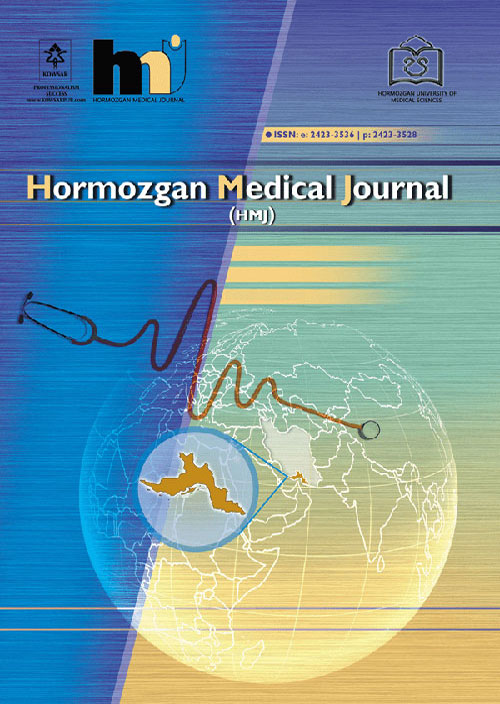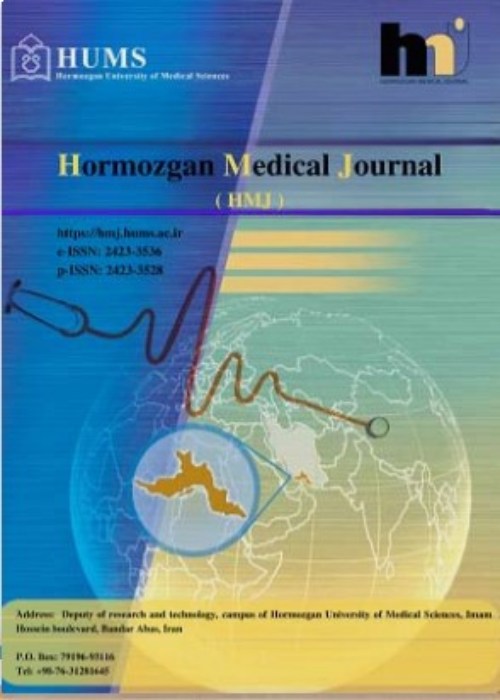فهرست مطالب

Hormozgan Medical Journal
Volume:25 Issue: 4, Dec 2021
- تاریخ انتشار: 1400/11/25
- تعداد عناوین: 9
-
-
Pages 153-159Background
The rapid spread of coronavirus disease 2019 (COVID-19) turned into a global pandemic and has already plunged health systems all over the world into an unprecedented crisis. The start of the third wave in the fall of 2020 is likely to trigger a higher prevalence in the upcoming months. This article analyzed the inpatients’ time series data in Hormozgan province to forecast the trend of COVID-19 inpatients using time series modelling.
MethodsTo forecast COVID-19 inpatients in Hormozgan province (Iran), this time series study included data related to the daily new cases of 1) confirmed inpatients, 2) suspected inpatients, 3) deaths, 4) alive discharged patients, 5) admitted cases to intensive care units (ICUs), 6) ICU discharged cases, and 7) ICU inpatient service day were collected from 22 hospitals in the province from 20 February to 13 November 2020. Autoregressive integrated moving average (ARIMAX) and Prophet methods were applied for forecasting the trend of inpatient indicators to the end of the Iranian official calendar year. We used the Python programming language for data analysis.
ResultsBased on the findings of this study which proved the outperformance of Prophet to ARIMAX, it can be concluded that time series of suspected inpatients, confirmed inpatients, recovered cases, deaths, and ICU-inpatient service day followed a downward trend while ICU-admission and discharge time series are likely taking an upward trend in Hormozgan to the end of the current Iranian calendar year.
ConclusionProphet outperformed ARIMAX for inpatient forecasting. By forecasting and taking appropriate prevention, diagnostic and treatment, educational, and supportive measures, healthcare policy makers could be able to control COVID-19 inpatient indicators.
Keywords: Forecasting, Interrupted time series analysis, Inpatients, COVID-19, Iran -
Pages 160-164Background
Development of psychological skills can be used to improve physical illnesses. Pain management strategies are one of the most important psychological skills and strategies that can help improve the disease. We aimed to investigate the effectiveness of self-care education and mindfulness-based stress reduction therapy on pain management strategies in patients with rheumatoid arthritis (RA).
MethodsThe statistical population of the study included patients with RA referred to rheumatology centers in Isfahan, from which 30 people were selected as a sample. In the study, the effect of two interventions of self-care education and mindfulness-based stress reduction therapy on coping strategies was evaluated and compared.
ResultsThe results showed that self-care training could have a significant effect on coping strategies (P=0.001). Mindfulness-based stress reduction therapy also had a significant effect on coping strategies (P=0.005) and comparing the effectiveness of two interventions showed that self-care training was significantly more effective than mindfulness-based stress reduction therapy on coping strategies in patients with RA.
ConclusionSelf-care training was more effective than mindfulness-based stress reduction therapy on coping strategies, and in general, both interventions were able to improve coping strategies in patients.
Keywords: Rheumatoid arthritis, Mindfulness, Pain, Self-care -
Pages 165-169Background
Painful symptoms of diabetic peripheral neuropathy (DPN) is common in patients with type 2 diabetes mellitus (T2DM), which can reduce the quality of life. The effect of aerobic training on neuropathic symptoms and quality of life in people with type 2 diabetes with peripheral neuropathy was investigated in the present study.
MethodsTwenty-four patients with DPN participated in this randomized controlled study. Participants were randomly assigned to the experimental or control groups. The experimental group underwent exercise training consisting of 20-45 minutes aerobic training on the treadmill at 50%-70% of heart rate reserve over three months. Before and after the experimental period, blood samples were taken in a fasting state, and Michigan Diabetic Neuropathy Score (MDNS), monofilament test and quality of life (QOL), and sleep quality (SQ) questionnaires were completed. Data analysis was performed using repeated-measures ANOVA.
ResultsIn the experimental group MDNS score significantly improved compared with the control condition (P<0.05). There was a significant difference between groups regarding 10 g monofilament test score (P<0.05). Moreover, QOL and SQ significantly improved in the experimental group with a significant inter-group difference (P<0.05). Hemoglobin A1c (HbA1c) level decreased by 7.4% in the experimental group, which was statistically different from the control group (P<0.05). Pearson’s correlation indicated a significant correlation between HbA1c level and monofilament score.
ConclusionRegular aerobic training over a short period potentially improves symptoms of DPN and QOL. Lowered levels of HbA1c were correlated with improved foot sensation.
Keywords: Type 2 diabetes mellitus, Diabetic neuropathy, Exercise training, Pain, Life quality -
Pages 170-174Background
Children with chronic kidney disease (CKD) experience many complications such as anemia, growth failure, stress and emotional problems. The responsibility for providing these children with proper health care is their family. The way parents of a child with CKD act is very important in the care of their child. We aimed to evaluate the level of performance of parents with children with CKD in Ahvaz.
MethodIn this descriptive cross-sectional study, census method was used for sampling. After completing the demographic questionnaires, the Family Assessment Device questionnaire (in general performance dimensions, communication, problem solving, role, emotional responsiveness, emotional involvement, behavior control) was used to assess parental performance of these children.
ResultsThe study involved 42 parents of children with CKD. The mean±SD age of the children was 9.85±1.22 and the mean±SD duration of illness was 11.18±9.38 months. The results showed that the scores related to general performance (P=0.001), performance communication (P=0.001), problem-solving function (P=0.024), performance role (P=0.038), emotional performance response (P=0.001), emotional performance involvement (P=0.001), performance behavior control (P=0.001) of the study population was significantly higher than the permissible value set by the questionnaire providers, indicating worse performance.
ConclusionThe results showed that parents of children with CKD did not have a sufficient level of performance in caring for their children. Therefore, it seems necessary to provide training programs for this group.
Keywords: Functional level, Chronic kidney disease, Child -
Pages 175-179Background
Bacterial vaginosis (BV) is one of the most common causes of abnormal vaginal discharge in women. The disease is characterized by an imbalance in the vaginal bacterial flora. We aimed to determine the frequency of Gardnerella vaginosis by cultivation and molecular method.
MethodsIn summer 2019, the vaginal secretion of 110 women with BV were collected and isolated for G. vaginalis, in Isfahan. The isolates were identified by the biochemical test. Polymerase chain reaction (PCR) was performed to detect G. vaginalis in vaginal secretions. Antibiotic susceptibility of the isolates was evaluated by disc diffusion method.
ResultsGardnerella vaginalis was isolated from five samples among the 110 patients with symptoms of BV by cultivation. Based on molecular identification, G. vaginalis was shown in 32 (29.1%) samples. G. vaginalis isolates were resistant to clindamycin (20%) and amoxicillin/clavulanic acid (80%). All the isolates were sensitive to Metronidazole. All women with this infection were married and most (43.8%) belonged to the 25-30 year-old age group. A significant difference was found between participants with positive clue cell (P<0.01) and pH>4.5 vaginal discharge (P<0.01) in the PCR-positive and the PCR-negative women.
ConclusionHigh prevalence of Gardnerella vaginalis in women with vaginosis confirms the important role of bacteria in the incidence of BV. Identification of pathogenic agents of G. vaginosis using molecular methods and determining their antibiotic susceptibility pattern is essential for proper treatment in different societies.
Keywords: Gardnerella vaginalis, Bacterial vaginosis, Drug resistant, Amsel criteria -
Pages 180-186Background
Pistachio with scientific name Pistacia vera L., a native plant in Asia, is a member of Anacardiaceae family. Pistachio nuts and skins are known as a rich source of phenolic compounds with antioxidant, anti-inflammatory and antimicrobial properties.
ObjectivesIn current study industrial production of phenolic compounds with antioxidant activity was investigated because of high mass production of Pistachio skin in Iran.
MethodThe extraction of two pistachio cultivars, namely Kallehghuchi and Ohadi were carried out by using two methods (maceration and ultrasonic extraction) and four solvents (acetone 70%, ethanol 50%, methanol 50% and water). Antioxidant properties of pistachio skins were determined by three methods (Folin-Ciocalteu colorimetric method, DPPH assay, TLC/DPPH analysis).
ResultsThe results showed that the highest content of total phenolic compounds were measured by ultrasonic and maceration methods related to Ohadi and Kallehghuchi in acetone solvents 17.4±0.04 and 17.26±0.1 mg/g DW respectively. The highest antioxidant activity in were measured by ultrasonic and maceration methods related to Ohadi in acetone and water solvents IC50=0.057±0.001 and 0.059±0.002 µg/mL respectively. By TLC/DPPH analysis, gallic acid, 4-hydroxy-3, 5-dimethoxy benzoic acid, tannic acid and some unidentified compounds were determined. By HPLC analysis, gallic acid, coumaric acid, cinnamic acid, 4-hydroxy-cinnamic acid and 4-hydroxy benzoic acid were determined.
ConclusionIn conclusion, this study clarifies some special biochemical characteristics of pistachio skins. Therefore, according to results of the study pistachio skins could be successfully used in food and pharmaceutical industries.
Keywords: Pistacia vera L., Antioxidant activity, Extraction, Phenol compounds -
Pages 187-191Background
There is little information about the effects of high intensity aerobic exercise training (HIT) and L-arginine supplementation on appetite-regulating hormones among obese male adolescents. We aimed to determine the effect of eight weeks of HIT and L-arginine supplementation on appetite-regulating hormones and body composition indices in obese adolescent boys.
MethodsTwenty obese adolescents were randomly divided into two groups of HIT and placebo (P-HIT, n=10) and HIT with supplementation of L-arginine (A-HIT, n=10). The HIT protocol was treadmill running with ventilation threshold (VT) intensity and training sessions were isoenergetic and energy consumption were set to 350 kcal per session for each participant, which were evaluated indirectly by calorimetry. The A-HIT group received 3 g of L-arginine per day for 8 weeks. Before the interventions and 48 hours after the last exercise session, anthropometric indices and levels of appetite-regulating hormones were measured.
ResultsThere was no significant changes between the groups with respect to leptin, agouti, and PYY3-36 peptide levels. There were significant changes in weight reduction between the groups (P≤0.05). However, body max index (BMI) and percent body fat (PBF) changes were not significant in between groups (P≥0.05).
ConclusionOur findings suggest that co-supplementation of L-arginine with HIT training had no further effects on appetite regulatory hormones and body composition of obese male adolescents.
Keywords: L-arginine, Leptin, Agouti, PYY3-36, High intensity training, Obesity -
Pages 192-197
Coronavirus disease 2019 (COVID-19) continues to spread rapidly worldwide with significant infection rates and the risk for the development of psychosis. Currently, most studies have focused on the clinical and epidemiological features of inpatients suffering from COVID-19. However, less attention has been given to the long-lasting consequences of this infectious disease. Strong epidemiological studies mainly from the past influenza pandemics suggest the positive association between prenatal infection and increased incidence of schizophrenia in the offspring. Therefore, it can be postulated that prenatal exposure to COVID-19 virus may put the offspring at risk for the development of schizophrenia. For this reason, longitudinal studies of this population may help elucidate the pathomechanisms involved in this complex illness and provide an opportunity for reducing the impact of this disorder on the next generation. In this review, we discussed the evidence for the association between in utero exposure to infection and schizophrenia risk in the offspring.
Keywords: SARS-CoV-2 virus, Prenatal viral infection, Schizophrenia -
Pages 198-201
The novel coronavirus infection 2019 (COVID-19) is a pandemic viral disease officially named by World Health Organization (WHO) on March 11, 2020. It is mainly a respiratory disease but can involve other organs. Extrapulmonary presentations are broad and not well recognized. COVID-19 may trigger diabetic ketoacidosis (DKA) in a patient with adequately controlled diabetes. Pregnancy is an incomplete immune suppression status, making women more susceptible to infections, and the disease-related morbidity is higher during pregnancy. Herein, we present the case of a 23-year-old diabetic pregnant woman at 28 weeks gestation with acute pancreatitis, DKA, hypertriglyceridemia, with confirmed COVID-19 infection using polymerase change reaction (PCR). She underwent antiviral therapy, adequate intravenous hydration, insulin infusion, and plasmapheresis in the intensive care unit (ICU). Her condition ultimately improved. COVID-19 with simultaneous pregnancy and diabetes mellitus increases the risk of metabolic disorders. Therefore, rapid diagnosis and adequate management would be considered.
Keywords: Case report, COVID-19, Diabetic ketoacidosis, Pancreatitis, Pregnancy


